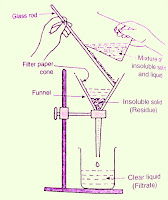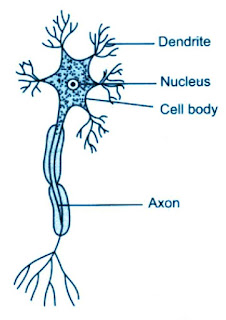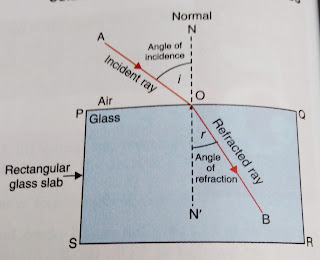NCERT Solution for Class 6 Science : Separation of Substances
Separation of Substances: In NCERT solution of class 6 chapter get questions answers, notes, solve paper.
Question 1:
Why do we need to separate different components of a mixture? Give two examples.
Answer 1:
We need to separate different components of a mixture because:
(i) to remove an undesirable component
(ii) to obtain the pure sample of a substance
(iii) to remove a harmful component
(iv) to obtain a useful component.
For example: (1) by the process of hand picking we separate small pieces of stones from food grains like rice, wheat, pulses. (2) by magnetic separation process we separate magnetic substance like iron nail from non magnetic substance such chalk, sand etc.
Question 2:
What is winnowing? Where is it used?
Answer 2:
Winnowing is the method of separating husk from grains with the help of wind.
Winnowing method is used to separate husk from various types of grains like wheat rice etc.
Question 3:
How will you separate husk or dirt particles from a given sample of pulses beforeCooking?
Answer 3:
Separate house or dirt particles from a given sample of pulses before cooking by the process called decantation. When we add water to pulses taken in a vessel, the impetus such as dust and soil particles get separated and mixed to water. Since pulses are heavy, they remain at the bottom of the vessel and dirty water is separated by decantation buy tilting the container to one side.
Question 4:
What is sieving? Where is it used?
Answer 4:
The method of separating a mixture whose components are different sizes by using a sieve is called sieving.
This process is used to (i) remove impurities from wheat before grinding, (ii) remove the course particles of flour (iii) fine sand can be separated from large particles by this process.
Question 5:
How will you separate sand and water from their mixture?
Answer 5:
The mixture of sand and water is separated by filtration. when the mixture of chalk and water is poured on the filter paper in a funnel, then Clear Water passes through the filter paper and collect into a beaker under it. The Saint remains behind on the filter paper.
Question 6:
Is it possible to separate sugar mixed with wheat flour? If yes, how will you do it?
Answer 6:
Yes. By using sieve we can separate sugar mixed with wheat flour. This process is called sieving.
Question 7:
How would you obtain clear water from a sample of muddy water?
Answer 7:
By the process of filtration we can get clear water form a sample of muddy water. first we put the sample muddy water on the filter paper. the water is easily pass through the filter paper and stored separately in a beaker placed under the filter paper. The mud remain on the filter paper
Question 8:
Fill up the blanks
(a) The method of separating seeds of paddy from its stalks is called ___________.
(b) When milk, cooled after boiling, is poured onto a piece of cloth the cream (malai) is left behind on it. This process of separating cream from milk is an example of ___________.
(c) Salt is obtained from seawater by the process of ___________.
(d) Impurities settled at the bottom when muddy water was kept overnight in a bucket. The clear water was then poured off from the top. The process of separation used in this example is called ___________.
Answer 8:
(a) The method of separating seeds of paddy from its stalks is called threshing.
(b) When milk, cooled after boiling, is poured onto a piece of cloth the cream (malai) is left behind on it. This process of separating cream from milk is an example of churning.
(c) Salt is obtained from seawater by the process of evaporation.
(d) Impurities settled at the bottom when muddy water was kept overnight in a bucket. The clear water was then poured off from the top. The process of separation used in this example is called sedimentation and decantation.
Question 9:
True or false?
(a) A mixture of milk and water can be separated by filtration.
(b) A mixture of powdered salt and sugar can be separated by the process of winnowing.
(c) Separation of sugar from tea can be done with filtration.
(d) Grain and husk can be separated with the process of decantation.
Answer 9:
(a) A mixture of milk and water can be separated by filtration. (False)
(b) A mixture of powdered salt and sugar can be separated by the process of winnowing. (False)
(c) Separation of sugar from tea can be done with filtration. (False)
(d) Grain and husk can be separated with the process of decantation. (False)
Question 10:
Lemonade is prepared by mixing lemon juice and sugar in water. You wish to add ice to cool it. Should you add ice to the lemonade before or after dissolving sugar? In which case would it be possible to dissolve more sugar?
Answer 10:
We at sugar before adding eyes to the juice. Because when the temperature is more than more sugar can dissolve in it.
Question 1:
Why do we need to separate different components of a mixture? Give two examples.
Answer 1:
We need to separate different components of a mixture because:
(i) to remove an undesirable component
(ii) to obtain the pure sample of a substance
(iii) to remove a harmful component
(iv) to obtain a useful component.
For example: (1) by the process of hand picking we separate small pieces of stones from food grains like rice, wheat, pulses. (2) by magnetic separation process we separate magnetic substance like iron nail from non magnetic substance such chalk, sand etc.
Question 2:
What is winnowing? Where is it used?
Answer 2:
Winnowing is the method of separating husk from grains with the help of wind.
Winnowing method is used to separate husk from various types of grains like wheat rice etc.
Question 3:
How will you separate husk or dirt particles from a given sample of pulses beforeCooking?
Answer 3:
Separate house or dirt particles from a given sample of pulses before cooking by the process called decantation. When we add water to pulses taken in a vessel, the impetus such as dust and soil particles get separated and mixed to water. Since pulses are heavy, they remain at the bottom of the vessel and dirty water is separated by decantation buy tilting the container to one side.
Question 4:
What is sieving? Where is it used?
Answer 4:
The method of separating a mixture whose components are different sizes by using a sieve is called sieving.
This process is used to (i) remove impurities from wheat before grinding, (ii) remove the course particles of flour (iii) fine sand can be separated from large particles by this process.
Question 5:
How will you separate sand and water from their mixture?
Answer 5:
The mixture of sand and water is separated by filtration. when the mixture of chalk and water is poured on the filter paper in a funnel, then Clear Water passes through the filter paper and collect into a beaker under it. The Saint remains behind on the filter paper.
Question 6:
Is it possible to separate sugar mixed with wheat flour? If yes, how will you do it?
Answer 6:
Yes. By using sieve we can separate sugar mixed with wheat flour. This process is called sieving.
Question 7:
How would you obtain clear water from a sample of muddy water?
Answer 7:
By the process of filtration we can get clear water form a sample of muddy water. first we put the sample muddy water on the filter paper. the water is easily pass through the filter paper and stored separately in a beaker placed under the filter paper. The mud remain on the filter paper
Question 8:
Fill up the blanks
(a) The method of separating seeds of paddy from its stalks is called ___________.
(b) When milk, cooled after boiling, is poured onto a piece of cloth the cream (malai) is left behind on it. This process of separating cream from milk is an example of ___________.
(c) Salt is obtained from seawater by the process of ___________.
(d) Impurities settled at the bottom when muddy water was kept overnight in a bucket. The clear water was then poured off from the top. The process of separation used in this example is called ___________.
Answer 8:
(a) The method of separating seeds of paddy from its stalks is called threshing.
(b) When milk, cooled after boiling, is poured onto a piece of cloth the cream (malai) is left behind on it. This process of separating cream from milk is an example of churning.
(c) Salt is obtained from seawater by the process of evaporation.
(d) Impurities settled at the bottom when muddy water was kept overnight in a bucket. The clear water was then poured off from the top. The process of separation used in this example is called sedimentation and decantation.
Question 9:
True or false?
(a) A mixture of milk and water can be separated by filtration.
(b) A mixture of powdered salt and sugar can be separated by the process of winnowing.
(c) Separation of sugar from tea can be done with filtration.
(d) Grain and husk can be separated with the process of decantation.
Answer 9:
(a) A mixture of milk and water can be separated by filtration. (False)
(b) A mixture of powdered salt and sugar can be separated by the process of winnowing. (False)
(c) Separation of sugar from tea can be done with filtration. (False)
(d) Grain and husk can be separated with the process of decantation. (False)
Question 10:
Lemonade is prepared by mixing lemon juice and sugar in water. You wish to add ice to cool it. Should you add ice to the lemonade before or after dissolving sugar? In which case would it be possible to dissolve more sugar?
Answer 10:
We at sugar before adding eyes to the juice. Because when the temperature is more than more sugar can dissolve in it.


